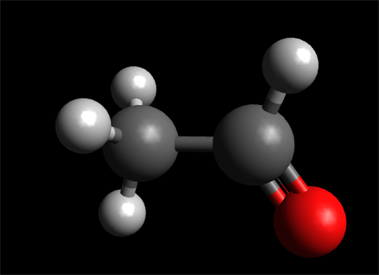Acetaldehyde (systematic name ethanal) is an organic chemical compound with the formula CH3CHO, sometimes abbreviated by chemists as MeCHO (Me = methyl). It has a molar weight of 44.05 g·mol−1
It is one of the most important aldehydes, occurring widely in nature and being produced on a large scale in industry. Acetaldehyde occurs naturally in coffee, bread, and ripe fruit, and is produced by plants.
Acetaldehyde is a colorless, flammable liquid used in the manufacture of acetic acid, perfumes, and flavors. It is also an intermediate in the metabolism of alcohol. It has a general narcotic action and also causes irritation of mucous membranes. Large doses may cause death from respiratory paralysis. Small amounts of acetaldehyde are produced naturally through gut microbial fermentation. Acetaldehyde is produced through the action of alcohol dehydrogenase on ethanol and is somewhate more toxic than ethanol. Acetaldehyde is linked to most of the negative clinical effects of alcohol. It has been shown to increase the risk of developing cirrhosis of the liver, multiple forms of cancer, and alcoholism. Acetaldehyde is found to be associated with aldehyde dehydrogenase deficiency, which is an inborn error of metabolism.
Acetaldehyde role in causing cancer
In our bodies, alcohol (ethanol) is converted into a toxic chemical called acetaldehyde in the liver.
Alcohol is metabolized by several processes or pathways. The most common of these pathways involves two enzymes—alcohol dehydrogenase (ADH) and aldehyde dehydrogenase (ALDH). These enzymes help break apart the alcohol molecule, making it possible to eliminate it from the body. First, ADH metabolizes alcohol to acetaldehyde, a highly toxic substance and known carcinogen . Then, in a second step, acetaldehyde is further metabolized down to another, less active byproduct called acetate , which then is broken down into water and carbon dioxide for easy elimination .Acetylaldehyde can cause cancer by damaging DNA and stopping our cells from repairing this damage. The International Agency for Research on Cancer have classified acetaldehyde formed as a result of drinking alcohol as being a cause of cancer, along with alcohol itself.
Acetaldehyde also causes liver cells to grow faster than normal. These regenerating cells are more likely to pick up changes in their genes that could lead to cancer.
